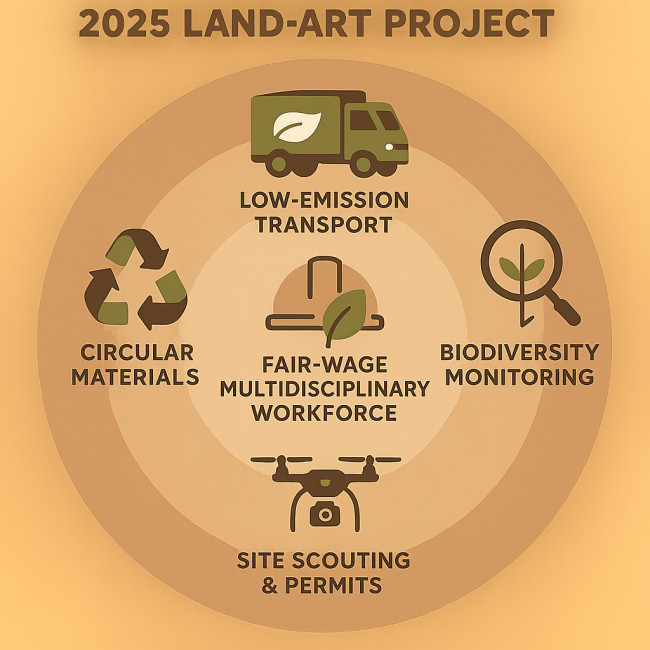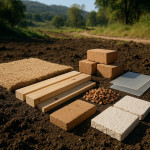Grant-ready budgets: align land art logistics with green funding criteria 2025
Winning a land-art grant in 2025 is as much about airtight logistics as it is about creative vision. This guide shows you how to structure a budget that ticks every green-funding box, persuades reviewers fast and keeps your installation profitable.
Why green funders scrutinise logistics first
Public and private eco-grants now allocate up to 60 % of their scoring to feasibility and impact. Reviewers want proof that your team can:
- Deliver on time without heavy carbon spikes.
- Restore the site to baseline biodiversity.
- Track and report measurable ecological gains.
The good news? Clear, data-backed logistics can boost your artistic score because judges see risk-free delivery as an extension of creative professionalism. A well-structured budget is your first credibility signal.
Five budget layers every 2025 grant panel expects

Before diving into the individual cost rows, picture your entire grant proposal as a layered ecosystem: the outer ring tracks scouting permissions that safeguard ecological baselines; the next captures recycled or biogenic materials that minimise toxicity; a third ring quantifies transport choices that shrink CO2e per kilometre; closer to the core sit the living wages that keep skilled artisans and ecologists on site; and at the very centre resides continuous monitoring, the heartbeat that proves long-term regeneration. Thinking in strata like this makes it easier for reviewers to map each euro to a climate-positive outcome, accelerates their scoring workflow and dramatically increases your chances of landing the funds. Use the forthcoming sections to assign precise percentages, uploadable documents and milestone triggers to every layer so nothing is left to interpretation when the panel meets.
1. Site scouting & permits (10 – 15 %)
Allocate funds for drone surveys, soil tests and permit fees. Linking to a workflow such as the one detailed in terrain and light scouting tactics shows that you have a timetable, not just an idea.
2. Materials & circular sourcing (25 – 35 %)
Choose soil-safe inputs certified for low toxicity—cement replacements, natural pigments, recycled stone. Cross-reference your list with the soil-safe materials checklist. Funders now request material passports; build their cost into this line.
3. Transport & on-site machinery (15 – 20 %)
Hybrid vehicles, GPS-optimised routing and shared freight services cut emissions by up to 40 %. Budget for them and note the savings in kg CO2e. If heavy cranes are unavoidable, offset the load with local tree-planting schemes priced into this row.
4. Workforce & safety (15 – 25 %)
Salaries, insurance and PPE must reflect fair-wage standards. Include specialist fees for ecologists—grants reward interdisciplinary teams. The permit pathway guide doubles as proof that you have proper oversight.
5. Monitoring, maintenance & restoration (10 – 15 %)
Set aside cash for quarterly biodiversity counts, drone fly-overs and a de-installation plan. This future-proofing reassures panels that the work ends with regeneration, not debris. See how to translate numbers into sponsor-friendly KPIs in land-art impact metrics.
Comparative cost table: budget layer vs. funder priority
| Budget layer | Typical share of total | Eco-criteria weight in reviews | Key documents |
|---|---|---|---|
| Site scouting & permits | 10-15 % | High | Drone maps, soil analysis |
| Materials sourcing | 25-35 % | Very high | Material passports, supplier certificates |
| Transport & machinery | 15-20 % | Medium | CO2 route plan, offset receipts |
| Workforce & safety | 15-25 % | Low | Fair-wage sheet, insurance proof |
| Monitoring & restoration | 10-15 % | High | Biodiversity baseline, de-install schedule |
Embed measurable eco-criteria from day one
Below are checkpoints that transform a simple cost sheet into a grant-magnet.
Use CO2e per euro as a scoring column
Attach an emission value to each budget row. Reviewers love numbers they can place in their dashboards.
Link costs to milestone deliverables
For example, “€4,200 for recycled basalt blocks” pairs with “Milestone 2: foundation complete – week 6”. Aligning cash flow with a timeline reassures panels that funds won't sit idle.
Build a digital audit trail
Upload receipts, material certificates and biodiversity photos to a shared folder. Grants often release the final 20 % only after evidence review. An online hub such as Artfolio's eco-design directory can double as your transparency portal.
Budget template: milestone vs. cash-flow
Copy this skeleton into your spreadsheet and fill in numbers:
- Milestone title (date) – Budget row – Amount – Eco metric – Evidence link.
- Repeat for every stage until restoration is complete.
Common pitfalls and quick fixes
- Ignoring contingency. Add a 5 % reserve ring-fenced for climate-related delays.
- Single-supplier risk. Identify two alternate green suppliers per material.
- Underpricing monitoring. Allocate at least 12 months of post-install data collection.
Interactive quiz: test your grant-budget readiness
FAQ
- Do I need an ecologist on the payroll or can I outsource?
- Panels prefer in-house expertise for faster decision loops, but outsourcing is acceptable if the contract and hours are clearly budgeted.
- Can volunteer labour count toward the workforce budget?
- Yes, but you must monetise their hours at local fair-wage rates and list them as in-kind contributions, not free labour.
- How detailed should CO2 calculations be?
- Use publicly available greenhouse-gas calculators and attach your methodology. Precision to the nearest 100 kg CO2e is usually sufficient.
- What happens if I underspend a budget row?
- You must notify the funder and propose a reallocation, typically towards monitoring or public engagement. Unreported savings can trigger clawbacks.
Take the next step
Download the full spreadsheet template, plug in your figures and start matching each cost to the latest green-funding criteria. With a transparent, milestone-driven budget, your land-art proposal moves from inspirational to investment-ready. Ready to refine your numbers? Reach out today and secure the backing your project deserves.











